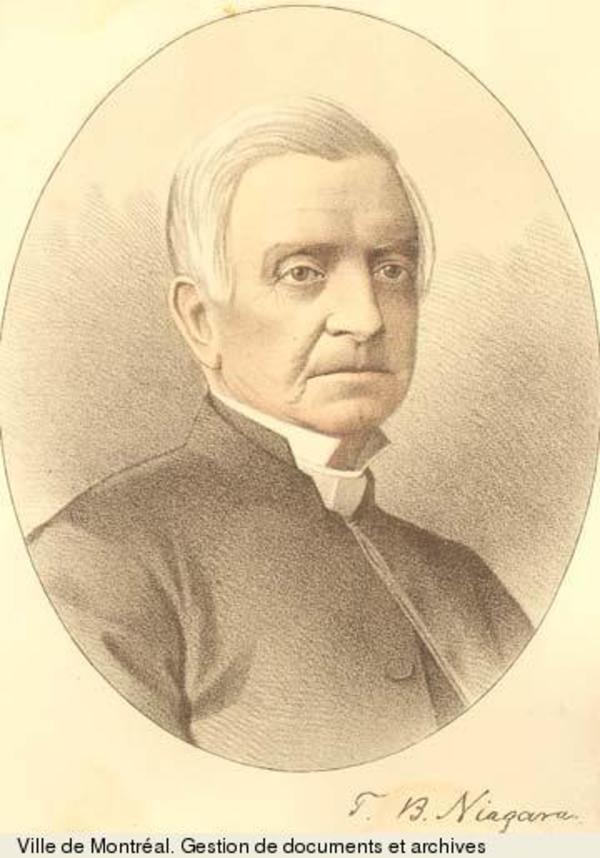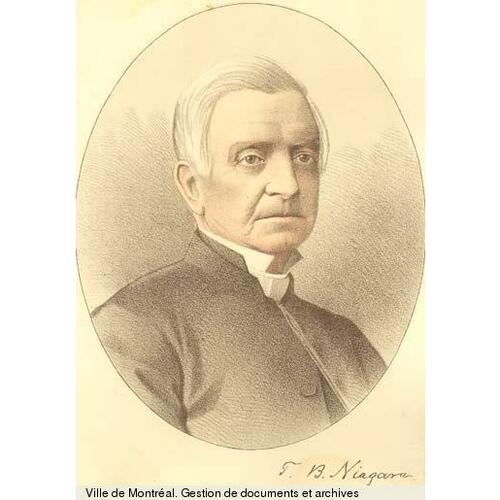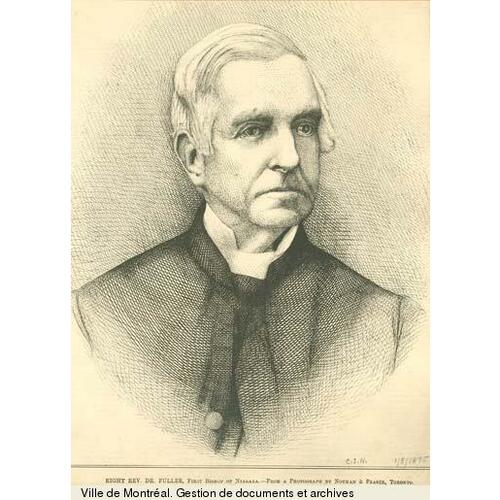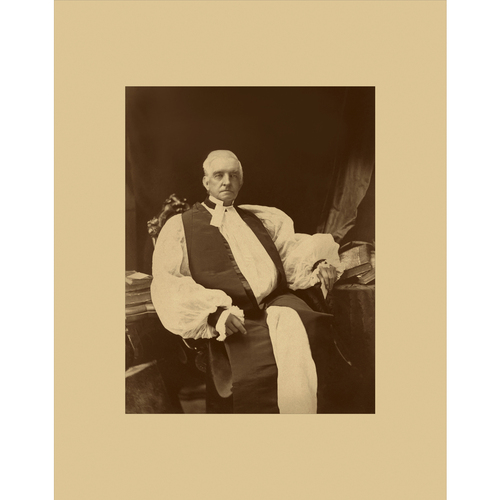
Source: Link
FULLER, THOMAS BROCK, Church of England clergyman and bishop; b. 16 July 1810 at Kingston, Upper Canada, son of Major Thomas Richard Fuller of the 41st Foot and Mary O’Brien England; d. 17 Dec. 1884 at Hamilton, Ont.
Thomas Brock Fuller was named after a godfather, Sir Isaac Brock*. Both of his parents were dead by 1817 and he was adopted by his mother’s sister Margaret, who later married William Leeming, a Church of England missionary in the Niagara District. After studying with the Reverend Thomas Creen in Niagara, Thomas enrolled at the Hamilton Grammar School and then at the Home District Grammar School at York (Toronto) where John Strachan* was schoolmaster. A scholarship awarded in 1828 by the Society for the Propagation of the Gospel enabled Fuller to attend Joseph Braithwaite’s seminary at Chambly, Lower Canada, until 1833 when he was ordained deacon. He served as assistant minister at Montreal and Lachine until 1835, being priested that January. On 14 May he married Cynthia Street of Chippawa (now part of Niagara Falls), daughter of merchant Samuel Street*. In character “the ideal parson’s wife,” she also “brought him a large fortune.” They were to have six sons and three daughters.
When Fuller was appointed rector at Chatham, Upper Canada, in 1836 the financial prospects of the Church of England in Canada did not look promising. Grants from the SPG for the church in the Canadas had recently been cut, and the clergy reserves were not an assured source of future income. In an anonymous pamphlet Fuller warned churchmen not to “depend upon the favor of government, or trust to the property we now hold.” He felt the church must enlist lay support and allow laymen some voice in disbursing church funds; Fuller later boasted of having been the first to suggest synodical government in the Canadian church, but John Strachan had broached the topic in 1832.
Convinced that the climate at Chatham was bad for his health, Fuller in 1840 accepted the rectorship at Thorold, Upper Canada, and he was named rural dean of Niagara by Bishop Strachan in 1850. At Thorold, Fuller became prominent in local affairs. He promoted the establishment of the Niagara District Agricultural Society, and was a vice-president of the Thorold Township Agricultural Society in 1847. In 1845 he had compiled the Canadian agricultural reader, and 13 years later became the first president of the mechanics’ institute in Thorold.
In Fuller’s view, preaching was an important aspect of the minister’s task. In 1879 he would state that he had seen the style of sermons change during his lifetime from elaborate, learned, dry essays to plain, earnest, practical addresses. His own voice was gentle and patient, and he advised others not to use manuscripts but to speak from the heart to the heart. Yet occasionally he himself must have used notes, for many of his sermons from the 1840s on were published. They frequently were concerned with disputes among religious bodies.
Fuller had declared in 1836 that clergy should be educated in Canada rather than in Europe-and had urged the establishment of a theological school in Upper Canada. Although he had no formal university training and later in life felt unfairly criticized for his lack of learning (after 1856 he added to his signature his honorary doctorate from Hobart College, Geneva, N.Y.), he always maintained a lively interest in education. At Chatham he sought to establish a church school, and at Thorold he became in 1857 one of the first trustees of the town’s grammar school. In 1867 Egerton Ryerson appointed him a member of the Council of Public Instruction for Canada West despite objections from the Globe because of his earlier advocacy of Anglican separate schools.
Fuller also gave support to Trinity College in Toronto. In 1852 he donated 200 acres of land in Sarnia to the college, and he gave $1,000 towards its endowment. The campaign begun by Wesleyan Methodists and members of the Church of Scotland to bring the colleges they had established under a single provincial university in order to obtain larger shares of available public funds was supported by Fuller who felt that his church should join them. As chairman of the synod’s committee on university education he tried unsuccessfully in 1862 to convince the synod that Trinity should become part of a reformed University of Toronto endowed by the government. Fuller was long a member of the Trinity College Council and often a member of its committees though at one point he felt “systematically excluded.” When Trinity sought to increase its endowments in the early 1880s, he angrily refused to help, but a few days before his death made a generous donation. The college had conferred an honorary dcl on him in 1857.
In 1861 Fuller had moved to Toronto to become rector of St George the Martyr. When Strachan in September 1866 sought the election of a coadjutor, Fuller drew enough support from laymen and the evangelical clergy to be a leading contender. Alexander Neil Bethune* was elected on the ninth ballot, but the defeat of an evangelical candidate was a factor which led to the founding of the Church of England Evangelical Association in 1868 [see Henry James Grasett]. Fuller was made a vice-president but later remained aloof from groups such as this set up in opposition to official bodies of the church.
By 1868 the diocese of Huron and Ontario had been set apart from Toronto, and a further division of the Toronto Diocese was suggested in 1869. It was not until 17 March 1875, however, that delegates from parishes in the counties of Lincoln, Welland, Wentworth, Haldimand, Wellington, and Halton met at Hamilton to choose a bishop. Fuller, archdeacon of Niagara since 1867, was elected over his closest rival, John Gamble Geddes, on the first ballot, receiving 32 of the 51 clerical votes and 33 of the 44 lay votes. Fuller was consecrated first bishop of the diocese of Niagara in St Thomas’ Church, Hamilton, on 1 May 1875, and he designated Christ’s Church, where Geddes was rector, as the cathedral.
One of the most pressing concerns for the new bishop was the form of public worship. He viewed with dismay many of the changes in it and sought to enforce uniformity; he warned his clergy against extempore prayer and disapproved of newly introduced liturgical practices. When in 1881 he discovered four of his younger clergy using alb and chasuble, he insisted on adherence to the legal decisions of the British courts regarding “ornaments.”
Fuller appreciated the contribution the SPG had made to the Canadian church, and when he attended the second Lambeth conference in 1878 he made an extensive speaking tour on behalf of the societet he always stressed the need for people to support their church, and had set an example by paying the £2,305 debt on St John’s Church in Thorold when he left it and by donations to the cathedral in Hamilton. His wife’s wealth enabled him to compensate for the inability of his parishes, or even of the new diocese, to pay an adequate stipend. About half the parishes of his diocese were mission parishes, and Fuller made great efforts to see his missionaries adequately paid. In the bitter negotiations over the division of funds between the dioceses of Toronto and Niagara, Fuller was particularly watchful that his mission parishes not suffer.
Although Fuller appears to have been reserved and formal, he received many expressions of appreciation from those who knew him. He seems to have found it difficult to acknowledge points of view other than his own; yet his idealism and untiring efforts, despite the physical infirmities which he suffered late in life, did much to strengthen the diocese of Niagara and the Anglican Church in Ontario.
T. B. Fuller was the author of The Canadian agricultural reader . . . (Niagara, [Ont.], 1845); “Christian unity,” Canadian Methodist Magazine, 19 (January–June 1884): 50–58, 138–50, 246–56; Diocese of Niagara: selections from the address of the lord bishop of Niagara, delivered at the annual session of the Synod of the Diocese of Niagara, on the 31st May, 1881 . . . (Hamilton, Ont., 1881); Extracts from the judgment of the Judicial Committee of the Privy Council of England, in certain ecclesiastical cases (Hamilton, 1881); Memoir of Mr. John Beatty . . . (Toronto, 1861); A nation’s mercy vouchsafed to a nation’s prayers: a sermon preached in St. George’s Church, Toronto, on Sunday, 25th February, 1872 . . . (Toronto, 1872); Thoughts on the present state and future prospects of the Church of England in Canada . . . ([Detroit], 1836; repr. Hamilton, 1887). References to other works by T. B. Fuller may be found in Biblio. of Canadiana (Staton and Tremaine).
AO, Strachan (John) papers, Letterbooks. St John’s Anglican Church (Thorold, Ont.), Fuller letters. Trinity College Arch. (Toronto), Trinity College records, A/II/3, 12 July 1870; A/II/4, 6 Aug. 1877, 25 June 1879, 29 Jan. 1880, 15 Dec. 1881. USPG, C/CAN/Tor, V, 45: f.519. Church of England, Diocese of Niagara, Synod, Journal (Hamilton), 1875–85; Diocese of Toronto, Synod, Journal (Toronto), 1865–75; Proc. (Toronto), 1853–64. Ecclesiastical Prov. of Canada, Synod, Journal of the proc. (Montreal), 1862. [Alexander] Dixon, Useful lives . . . a sermon . . . preached in Christ Church Cathedral, Hamilton, September 7th, 1883 . . . (Toronto, 1884). Doc. hist. of education in U.C. (Hodgins), I: 229; XIV: 254; XVI: 61, 227–28; XVII–XX. Christian Guardian, 2 March, 27 April, 18, 25 May, 1 June 1842. Church (Cobourg, [Ont.], and Toronto), 29 July 1837; 30 March 1839; 23 April, 18 June 1842. Hamilton Spectator, 17, 18 March, 1, 3 May 1875; 17 Dec. 1884. St. Catharines Journal (St Catharines, [Ont.]), 10 Sept. 1857. Chadwick, Ontarian families, I: 49–50. Dent, Canadian portrait gallery, IV: 125–26. J. L. H. Henderson, “John Strachan as bishop, 1839–1867” (dd thesis, General Synod of Canada, Anglican Church of Canada, 1955). Jubilee history of Thorold, township and town . . . (Thorold, 1897–98), 100–3, 113–17, 135–41, 163–68. John Langtry, History of the church in eastern Canada and Newfoundland (London, 1892), 245–49. Some men and some controversies; published on the occasion of the centennial of the diocese of Niagara, ed. R. [E.] Ruggle (Erin, Ont., 1974). R. [E.] Ruggle, “Thomas Brock Fuller: first bishop of Niagara,” Wentworth Bygones (Hamilton), 10 (1973): 23–36.
Cite This Article
Richard E. Ruggle, “FULLER, THOMAS BROCK,” in Dictionary of Canadian Biography, vol. 11, University of Toronto/Université Laval, 2003–, accessed January 4, 2026, https://www.biographi.ca/en/bio/fuller_thomas_brock_11E.html.
The citation above shows the format for footnotes and endnotes according to the Chicago manual of style (16th edition). Information to be used in other citation formats:
| Permalink: | https://www.biographi.ca/en/bio/fuller_thomas_brock_11E.html |
| Author of Article: | Richard E. Ruggle |
| Title of Article: | FULLER, THOMAS BROCK |
| Publication Name: | Dictionary of Canadian Biography, vol. 11 |
| Publisher: | University of Toronto/Université Laval |
| Year of publication: | 1982 |
| Year of revision: | 1982 |
| Access Date: | January 4, 2026 |





